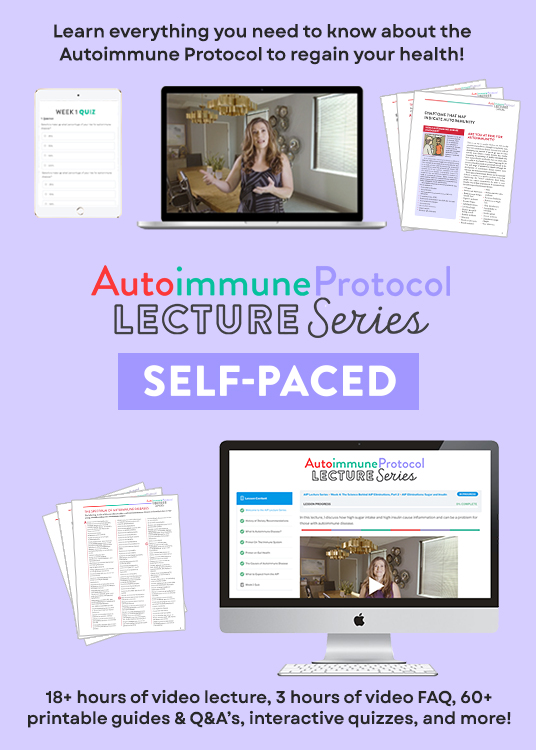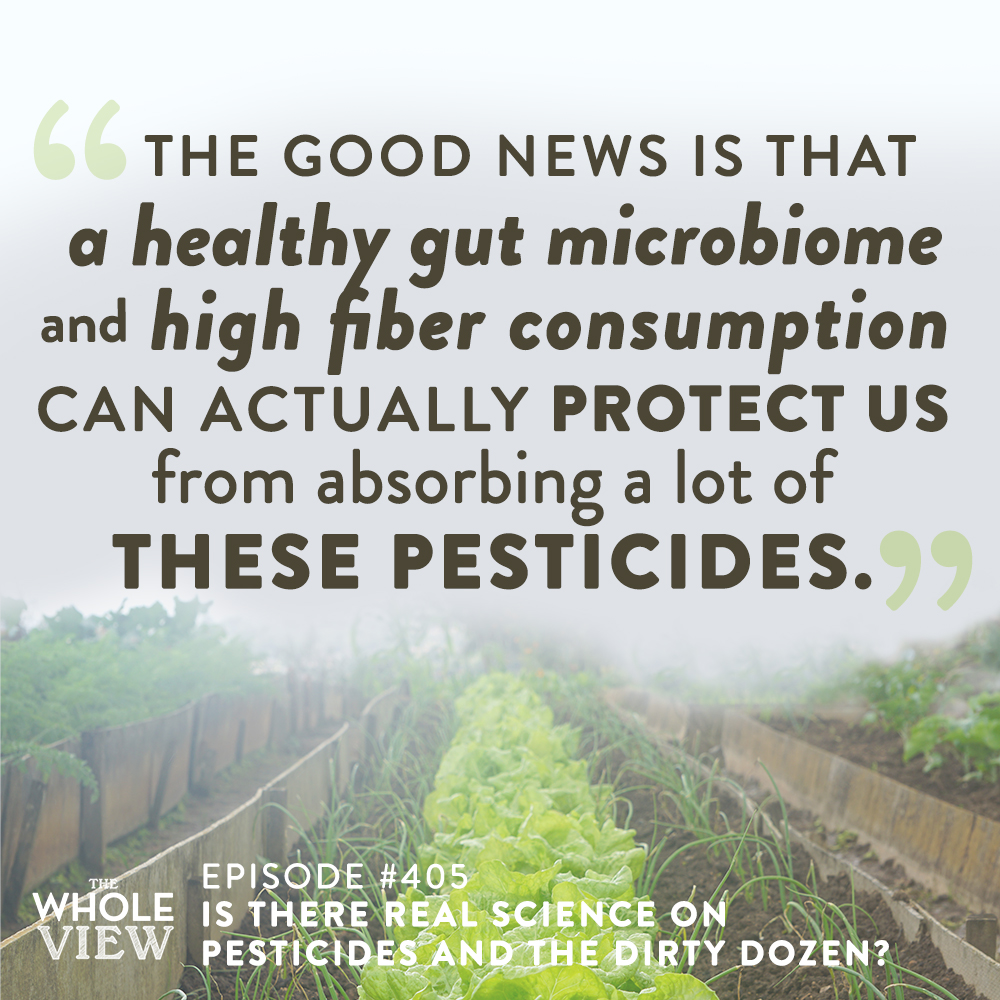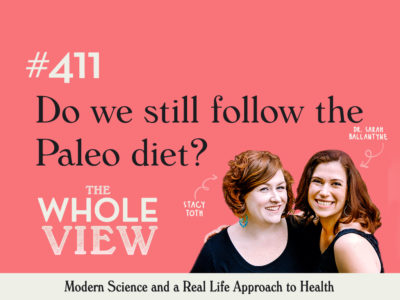Welcome to episode 405 of The Whole View! This week Stacy and Sarah address a listener’s question about the research behind the ‘Dirty Dozen’ and ‘Clean Fifteen’ lists. Learn about pesticide residue absorption and how you can minimize your exposure. Enjoy!
Table of Contents[Hide][Show]
- The Whole View, Episode 405: Is there real science on Pesticides and the Dirty Dozen?
- Listener Question
- Preface
- Foundational Choices & Next Level Choices
- Conventional Evaluation of Pesticide Safety
- Where the Standards Differ
- Pesticides and the Microbiome (Sarah’s Biggest Concern)
- More Commonly Used Pesticides
- Two More Commonly Used Pesticides
- More on Glyphosate
- How to Look at this Science
- How to Limit Pesticide Exposure
- Closing Thoughts
If you enjoy the show, please review it on iTunes!
The Whole View, Episode 405: Is there real science on Pesticides and the Dirty Dozen?
Welcome back to episode 405 of the Whole View. (0:27)
Today Stacy and Sarah are talking about a super interesting topic submitted a listener.
Which, if you didn’t know this already, we love it when you email us.
Sarah shared some behind the scenes information on where listener questions come from.
There are Stacy’s requests, listener questions, and the really challenging listener questions.
The question in discussion in this episode is one of those really hard ones that has been in the queue for a long time.
Sarah was able to pull together the information for this show because she actually did a lot of research on this topic for her gut microbiome book.
And of course, Sarah did extra research to address the many facets of this challenging question.
Stacy is excited about this science rich show.
Save 70% Off the AIP Lecture Series!
Learn everything you need to know about the Autoimmune Protocol to regain your health!
I am loving this AIP course and all the information I am receiving. The amount of work you have put into this is amazing and greatly, GREATLY, appreciated. Thank you so much. Taking this course gives me the knowledge I need to understand why my body is doing what it is doing and reinforces my determination to continue along this dietary path to heal it. Invaluable!
Carmen Maier

Listener Question
Is the EWG’s dirty dozen list based on strong science? (3:37)
My husband listened to two episodes of the Skeptoid podcast on organic vs. conventional farming.
Mr. Dunning said that we are being duped into paying extra for organic produce.
It is sprayed with larger amounts of pesticides than those used in conventional farming and the organic pesticides have been shown to cause disease.
My husband believes Mr. Dunning because he provides references and appears to be liberal and non-biased in other podcasts.
I have been purchasing organic produce according to the Environmental Working Group’s dirty dozen list.
It says on the Activist Facts website that “There’s really only one thing you need to know about the Environmental Working Group when it comes to its studies of toxins: 79 percent of members of the Society of Toxicology (scientists who know a little something about toxins) who rated the group say that the Environmental Working Group overstates the health risk of chemicals.
I am walking around with holes in my shirts, and I haven’t gotten the air conditioning fixed in my car, so that I can afford organic food.
Am I wasting my money?
I feel like I cannot trust anyone but you.
Preface
Stacy wanted to refer listeners to listen back to previous episodes for information on how both Stacy and Sarah have evolved the way they purchase and prioritize their own foods within their budget. (5:06)
Neither Stacy nor Sarah buys everything organically.
Nothing that Stacy and Sarah are going to discuss in this episode is intended to be a judgment on you or your family or what you did in the past or what you are doing now.
This is all education so that you can be empowered to make the choices that are best for your family at the correct time for you.
Where Stacy’s family is today, ten years later, is a lot different than where they were ten years ago.
The goal of this episode is to help you so that you can walk away and ask questions.
There is a larger philosophy that each family needs to adapt to what works best for them.
No one is perfect.
If you are starting in your journey, you don’t need to forego the necessities to have organic food.
There is a way to prioritize your budget in a way that is consistent with what your family believes in.
Healthy living choices are so personal.
Foundational Choices & Next Level Choices
Sarah wanted to emphasize that there are foundational health principles.
Nutrient density diet, eating a lot of fruits and vegetables, getting enough sleep, managing stress, and living an active lifestyle.
Then Sarah thinks of the next level steps like adding some biohacks, supplements, purchasing grass-fed beef, and organic fruits and vegetables.
We need to first make sure that we are focusing on the foundational principles and adding in the next level choice if and when it makes sense.
Eating organic is beyond the basic principles, but is overall a better choice.
The EWG’s overall approach is in many ways more rigorous than the American regulatory agencies.
The EWG tends to align with the European Union, Health Canada, and these other regions of the world where the criterion for approving a chemical or pesticide is firmer.
In America, the thought process is that chemicals are assumed fine unless proven bad.
In Europe, a chemical is not ok until proven safe.
Conventional Evaluation of Pesticide Safety
The FDA’s safety assessment for chemicals in foods have a variety of criteria. (13:11)
They look at acute chronic and subchronic toxicity, carcinogenicity, genotoxicity, reproductive and developmental toxicity, neurotoxicity, and immunotoxicity.
Pesticides also go through additional impact evaluation on the environment and ecology.
The vast majority of the studies evaluating the effects of pesticides show problems to human health only with occupational exposure, rather than the much lower exposure the majority of us would have simply by eating produce from crops treated with these chemicals.
However, there are some challenges with this.
We can see high exposure in rodents causing all kinds of problems.
The assumption is that acute exposure is not the same as low dose chronic exposure.
Where the Standards Differ
One of the challenges that we have in evaluating pesticides is that our exposure is already so vast.
There are no humans that don’t already have multiple points of exposure to pesticides.
There are studies that are linking the chronic low dose exposure to pesticide residues that have correlated pesticide exposure in the food supply with a number of health issues.
In the United States, there are 72 pesticides that are routinely used that are completely banned or are in the process of being completely phased out in Europe.
Of the pesticides used in USA agriculture in 2016, 322 million pounds were of pesticides banned in the EU.
Twenty-six million pounds were of pesticides banned in Brazil and 40 million pounds were of pesticides banned in China.
Pesticides banned in the EU account for more than a quarter of all agricultural pesticide use in the USA.
It is important to understand that the European Union is looking at the same science as the EPA.
And they are making a different judgment based on the strength of the data.
We have a challenge that our metric is, ‘is it toxic’ and ‘does it cause cancer’.
WHO Guidelines for Safety of Chemicals in Food are much more thorough, and add to the above.
They include general system toxicity, allergy and hypersensitivity, and GI Tract Considerations (includes microbiome).
Pesticides and the Microbiome (Sarah’s Biggest Concern)
Microbial diversity is generally considered to be the most important measurable criteria for a healthy microbiome. (24:31)
The more different species you have, they tend to keep each other in balance.
The bacteria basically control the growth of each other.
We are also looking for the growth of these really important probiotic strains.
In addition, we are looking for completely absent levels of pathogens.
We are also looking at the balance between the two main phylum of bacteria in the gut.
It is important to understand that rodent studies are actually really good studies for understanding the gut microbiome.
We would want to eventually be able to do a similar study in humans.
But what Sarah wants to emphasize is that these rodent studies are a really good model for understanding what is happening in humans.
Let’s go through some of the most commonly-used pesticides in agriculture for food crops.
Permethrin is a broad-spectrum chemical often used as an insecticide for cotton, corn, alfalfa, and wheat crops—unfortunately, it’s also lethal to bees.
It’s also used to treat lice, ticks, and scabies.
For more on this, visit this link here.
PEM has higher antibacterial activity against some beneficial bacteria, (including Lactobacillus paracasei and Bifidobacterium).
Than against pathogens (such as Staphylococcus aureus and Escherichia coli, which only respond to higher concentrations of PEM).
Carbendazim (CBZ) is a broad-spectrum benzimidazole fungicide, widely used in agriculture.
In mice, 28 days of exposure to CBZ resulted in gut dysbiosis.
It suppresses the growth of some of the most important probiotic families while increasing the growth of some problematic families of bacteria.
And it decreases bacterial diversity.
To learn more about this pesticide, see here.
Epoxiconazole (EPO) is a broad-spectrum fungicide often used on grain crops, and that works by inhibiting the metabolism of fungal cells.
It reduces the production of conidia—the asexual spores of a fungus that facilitate reproduction.
In rats, EPO for 90 days decreased the relative abundance of Firmicutes and increased the abundance of Bacteroidetes and Proteobacteria, while also selectively enriching Lachnospiraceae and Enterobacteriaceae.
To learn more about this pesticide, see here.
More Commonly Used Pesticides
Imazalil (IMZ) is a systemic fungicide used to combat fungi on vegetables and fruit (especially citrus), as well as tubers during storage. (30:39)
In mice, IMZ exposure (at doses of 100 mg per kg of body weight daily for up to 14 days) reduced the cecal relative abundance of Bacteroidetes, Firmicutes, and Actinobacteria, while also reducing microbiota richness and diversity.
The IMZ-treated mice also exhibited colonic inflammation.
In another study of mice, low-dose, environmentally relevant exposure to IMZ (0.1, 0.5, or 2.5 mg per kg of body weight daily) for 15 weeks resulted in gut microbiota changes.
These changes included reduced mucus secretion, decreased the expression of genes related to cystic fibrosis transmembrane conductance regulator (CTFR) in the ileum and colon, and generally disturbed intestinal barrier function.
Stacy shared her perspective on how she looks at this information.
Think through the way how these pesticides are more heavily used on grains.
Chlorphyrifos (CPF) is an extremely common organophosphate pesticide used to kill insects and worms, by interfering with acetylcholine signaling and disrupting their nerve processes.
It’s commonly used on fruit and vegetable crops, as well as vineyards.
This is one that was going to be banned in the USA, but Scott Pruitt reversed the planned ban.
You can learn more about this here.
Sarah shared on this study, this study, this study, and this study.
This information should stimulate a reevaluation of the use of these chemicals in the food supply.
Diazinon is an organophosphate insecticide used on a variety of crops—including fruit trees, rice, sugarcane, nuts, potatoes, and corn.
You can learn more about this pesticide here.
It causes different changes in male rodents versus female rodents.
The researchers speculated that these differences—with male mice experiencing the most severe changes—were due to sex-dependent gut microbiota profiles present before treatment.
You can read more about this study here.
Two More Commonly Used Pesticides
Propamocarb (PMEP) is a systemic fungicide used to control root, leaf, and soil diseases caused by oomycetes (water molds) by interfering with fatty acid and phospholipid biosynthesis and therefore changing the membrane in fungi. (41:41)
It can accumulate in fruit at high levels, thus reaching humans.
You can find more information on this pesticide here.
In mice, 28 days of exposure to PMEP (at levels of 300 mg/L in drinking water) induced gut dysbiosis and changes in 20 fecal metabolites, including SCFAs, succinate, bile acids, and TMA.
You can read more about this study here.
Glyphosate is a broad-spectrum herbicide that can kill both grasses and leafy weeds.
It works by inhibiting an enzyme (5-enolpyruvylshikimic acid-3-phosphate synthase, or EPSP synthase), which is used by bacteria, archaea, fungi, algae, some protozoans and plants to synthesize folates (vitamin B9), ubiquinone, menaquinones (vitamin K2), phenolic compounds, and the aromatic amino acids tyrosine, tryptophan, and phenylalanine.
The pathway this affects doesn’t exist in animals, which is part of why glyphosate has historically been considered to have low toxicity in animals.
Now that we understand that we have at least as many bacterial cells living within our body as we do human cells and that those bacteria are essential to our health, the relevance of glyphosate exposure comes into focus.
Many bacterially-derived compounds that benefit human health are produced via the shikimate pathway.
One rat study evaluated the impact on the microbiome of two weeks of glyphosate consumption, and showed a dose-dependent increase in fecal pH attributable to a reduction in acetic acid production, implying the metabolomic impact of glyphosate exposure.
More on Glyphosate
It’s not that glyphosate is necessarily directly impacting our cells, but it is dramatically impacting the gut microbiome at levels that we are already being exposed to in the food supply. (48:50)
In studies in poultry, cattle, and pigs, glyphosate exposure increases the ratio of pathogenic bacteria to probiotic microbes, reducing Bifidobacteria, Lactobacillus, and Enterococcus while increasing Salmonella and Clostridium.
In a long-term rat study, the impact on the gut microbiome was evaluated following nearly two years of glyphosate exposure via drinking water at three different doses.
Glyphosate caused a large increase in the Bacteroidetes family S24-7 (associated with obesity and inflammation) and a decrease in Lactobacillus species in females (more modest changes in males).
It also altered the Firmicutes to Bacteroidetes ratio to one more closely associated with chronic disease.
The authors concluded “our data suggests that the exposure to an environmental concentration of [Roundup] residues could have a role in the current epidemic of gut dysbiosis”.
This occurs even at levels well below the US ADI of 1.75 mg/kg body weight /day.
There is no strong dose-response.
Sarah wants to emphasize that our glyphosate exposure in food is quite high.
It is definitely above the cusp for an impact on our gut microbiome composition.
The FDA has a report where they have been mandated to measure glyphosate residue in the food supply.
In their 2016 report they measured measurable levels of glyphosate residues in 63% of corn food crops and in 67% of soybean food crops.
However, they did not say how much residue was there.
The 2018 report goes to a dead link now.
A Swiss study of foods purchased at a grocery store showed that legumes had the highest concentrations of glyphosate residues, up to 2.95 mg/kg.
United Kingdom government testing of glyphosate residues in wholegrain bread showed levels up to 0.9 mg/kg.
A study of foods purchased in Philadelphia, USA metropolitan area showed 59 percent of honey samples contained glyphosate residues, and 36 percent of soy sauce contained glyphosate residues.
Third-party testing of popular breakfast cereals, crackers, and cookies by the Detox Project and Food Democracy Now! showed alarming levels of glyphosate residues in all products.
Roundup Ready GMOs have the highest level of glyphosate residues.
Studies prove that our current levels of exposure are sufficient for measurable amounts of glyphosate to get into our bodies.
One study showed that 44% of city dwellers in 18 countries in Europe had detectable glyphosate residues in their urine, despite Europe’s more aggressive campaign against GMO foods.
A pilot study in the United States of America evaluating 131 urine samples from across the country detected glyphosate residues in the urine of 86.7% of them.
The highest observed detection frequency in the Midwest was at 93.3% and the lowest in the South at 69.2%.
How to Look at this Science
The EWG is looking at this much more broad group of criteria and they are taking a very similar standpoint to the European Union. (58:09)
A small effect is still an effect and we need to be concerned about it.
When Sarah does a deep dive look to look at the impact on the gut microbiome this is where Sarah sees the biggest area of concern.
Sarah thinks it is especially important because it is not currently part of the criteria by the FDA and the EPA for whether or not these chemicals are going to be approved for use.
This is the thing that Sarah really thinks needs to change.
The good news is that a healthy gut microbiome and high fiber consumption can actually protect us from absorbing a lot of these pesticides.
There have been studies that showed that lactobacilli can help reduce how much pesticide on our food gets into our bodies.
There are also studies that show that higher fiber consumption can at least partially reverse the gut dysbiosis.
As we get back to the heart of this question, there are studies that show that the answer is no.
High vegetable consumption is still really important because it does support a healthy gut microbiome, to begin with.
And a healthy gut microbiome is going to protect us in a lot of ways.
For example, they can protect us against heavy metals.
Even if we can’t afford organic to not let that dissuade us from eating that high vegetable consumption because of this.
Sarah sees this as an exciting two-way street.
Even though pesticide residues are impacting the composition of our guts, the composition of our gut is influenced by more than just that.
It is influenced by how many fruits and vegetables we eat, mushrooms, nuts and seeds, variety, how much fish, how quality the olive oil is that we are consuming, etc.
All of these things help to determine the composition of our gut microbiome.
Doing all of these foundational things becomes more important when we are not necessarily in a position to be able to seek out and afford the highest food quality.
It is still really important to eat a vegetable-rich diet.
That’s why Sarah wants to classify all of this science as the next level.
The foundational principle is still eating a lot of fruits and vegetables, even if our only access to that is conventional.
Beyond that, yes the Dirty Dozen and Clean Fifteen lists from the EWG are a wonderful tool.
Not that Sarah agrees with everything the EWG has said, Sarah thinks that these are spot on in the sense of trying to minimize our exposure to pesticide residues.
How to Limit Pesticide Exposure
Stacy feels that the podcast referenced and the information they are sharing aren’t so far apart. (1:02:10)
Sarah and Stacy discussed a point shared in the documentary Food Inc. that really hit this information home.
We do the best that we can with what we can, and become educated on what other things we can do to support healthy living.
Nothing is ever perfect.
Prioritize the foods you purchase and do the best you can.
It is not good to stress about these things.
The dirty dozen list includes strawberries, spinach, kale, nectarines, apples, grapes, peaches, cherries, pears, tomatoes, celery and potatoes
The clean fifteen list includes avocados, sweet corn, pineapple, onions, papaya, sweet peas (frozen), eggplants, asparagus, cauliflower, cantaloupes, broccoli, mushrooms, cabbage, honeydew melon, and kiwifruit.
If you are going to get something off the dirty dozen conventional, look at ways that you can wash that food very well or ways you can peel the food to remove the majority of the pesticide residue.
USDA certification is very expensive, so a lot of small family farms are growing organically, but don’t have the certification.
Talk to farmers and find out how they are growing their food.
Stacy can’t handle the sight of bugs in her fresh vegetables.
Eating fruits and vegetables is a good thing.
Perfection is not the goal.
Neither Stacy nor Stacy eats 100% organic, they both do the best that they can.
Sarah has found that the prices at her local farmer’s market are best.
Develop relationships with your local farmers, and shop at the end of the market.
Stacy subscribes to Hungry Harvest, which has a waiting list right now.
Sarah prescribes to MisFit Market, there is also one called Imperfect Produce.
One of the things that Sarah loves about her subscription is the surprise element of it, which forces her to get creative with her meal planning.
At Stacy’s house they meal plan when their box arrives, based on what they received.
Stacy shared more information on their meal planning process as a family, and how focused they have become to make sure they are not wasting food.
Building relationships with your local farmers is a point that Stacy echoed from Sarah.
Buying things in season or frozen can also be a helpful way to save money.
Stacy’s organic box is at least 30% off had they purchased those items at a grocery store regularly.
The thing that Stacy most loves about Hungry Harvest is that they give back to the community.
Closing Thoughts
Stacy thanked Sarah for all the research she did for this show! (1:23:13)
If you have any follow up questions on all of this, you are welcome to email Stacy and Sarah using the contact forms on their blogs.
You can comment on social media posts as well.
Stacy and Sarah are always happy to hear from you!
If you have been loving this show, please help spread the word to others by sharing a link to an episode you enjoyed with a family or friend, or leave a review.
Stacy and Sarah so greatly appreciate your support!
Thank you again for tuning in!
Next week is another science-heavy show that builds off of this week’s episode.
We will be back again next week! (1:25:57)










